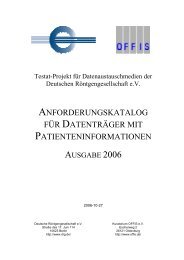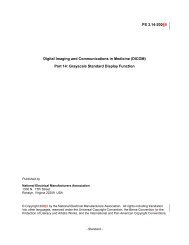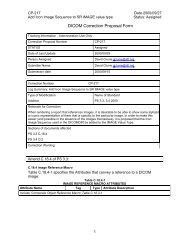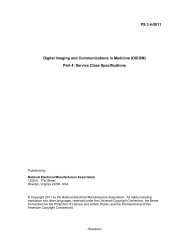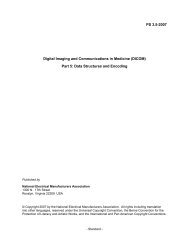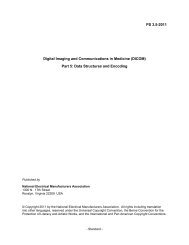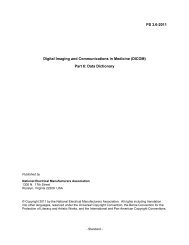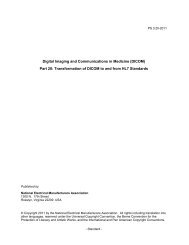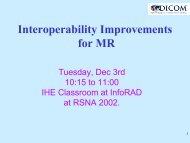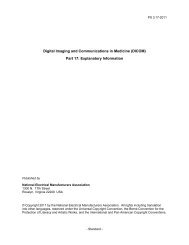Security Profiles - Dicom - NEMA
Security Profiles - Dicom - NEMA
Security Profiles - Dicom - NEMA
Create successful ePaper yourself
Turn your PDF publications into a flip-book with our unique Google optimized e-Paper software.
Annex B SECURE TRANSPORT CONNECTION PROFILES<br />
(Normative)<br />
B.1 THE BASIC TLS SECURE TRANSPORT CONNECTION PROFILE<br />
PS 3.15-2003<br />
Page 17<br />
An implementation that supports the Basic TLS Secure Transport Connection Profile shall utilize the<br />
framework and negotiation mechanism specified by the Transport Layer <strong>Security</strong> Version 1.0 protocol.<br />
Table B.1-1 specifies mechanisms that shall be supported if the corresponding features within TLS are<br />
supported by the Application Entity. The profile does not require the implementation to support all of the<br />
features (entity authentication, encryption, integrity checks) of TLS. Other mechanisms may also be used<br />
if agreed to by negotiation during establishment of the TLS channel.<br />
Table B.1-1<br />
Minimum Mechanisms for TLS Features<br />
Supported TLS Feature Minimum Mechanism<br />
Entity Authentication RSA based certificates<br />
Exchange of Master Secrets RSA<br />
Data Integrity SHA<br />
Privacy Triple DES EDE, CBC<br />
IP ports on which an implementation accepts TLS connections, or the mechanism by which this port<br />
number is selected or configured, shall be specified in the Conformance Statement. This port shall be<br />
different from ports used for other types of transport connections (secure or unsecure).<br />
Note: It is strongly recommended that systems supporting the Basic TLS Secure Transport Connection Profile<br />
use as their port the registered port number “2762 dicom-tls” for the DICOM Upper Layer Protocol on<br />
TLS: (decimal).<br />
The Conformance Statement shall also indicate what mechanisms the implementation supports for Key<br />
Management.<br />
The profile does not specify how a TLS Secure Transport Connection is established, or the significance of<br />
any certificates exchanged during peer entity authentication. These issues are left up to the Application<br />
Entity, which presumably is following some site specified security policy. The identities of the certificate<br />
owners can by used by the application entity for audit log support, or to restrict access based on some<br />
external access rights control framework. Once the Application Entity has established a Secure<br />
Transport Connection, then an Upper Layer Association can use that secure channel.<br />
Note: There may be an interaction between PDU size and TLS Record size that impacts efficiency of transport.<br />
The maximum allowed TLS record size is smaller than the maximum allowed PDU size.<br />
When an integrity check fails, the connection shall be dropped per the TLS protocol, causing both the<br />
sender and the receiver to issue an A-P-ABORT indication to the upper layers with an implementationspecific<br />
provider reason. The provider reason used shall be documented in the conformance statement.<br />
Note: An integrity check failure indicates that the security of the channel may have been compromised.



